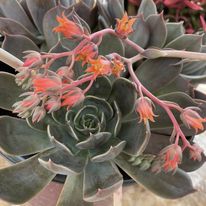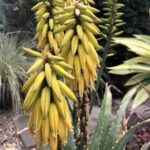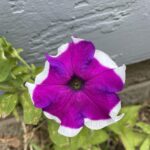Description
Echeveria is a large and diverse genus of flowering succulent plants native to Mexico. These plants are known for their tight rosette clusters that stay close to the ground, unlike some other succulents that grow long stems. Echeveria is a hardy genus, with some species being evergreen, making them a popular choice for both novice and experienced gardeners. They propagate themselves through offshoots and seeds, usually producing new growth once per season. Their resilience and striking appearance make Echeveria a favorite at Gen1 Greenhouse.
Hardiness
Echeveria is generally hardy, tolerating USDA hardiness zones 9-11. They prefer warm temperatures and can withstand brief periods of cold, but prolonged exposure to frost can damage the plants. In colder climates, it is best to grow Echeveria in containers that can be brought indoors during winter or to provide frost protection.
How to Care for Echeveria
Sunlight
Echeveria plants thrive in 6-8 hours of partially shaded to direct sunlight each day. These succulents are well-suited for the extreme heat and intense sunlight of the Mexican deserts, so growing them in a windowsill is not ideal unless it gets plenty of direct sun. Without enough sunlight, Echeveria may grow leggy and lose their vibrant colors, turning a dull green. If this happens, you can rejuvenate the plant by beheading it, a process where you cut off the top to encourage new growth. For more details on this method, refer to our Succulent Propagation Guide.
Watering
Proper watering is crucial for maintaining healthy Echeveria plants. Water once a week or whenever the soil has completely dried out. Overwatering can lead to root rot, while under-watering can cause the plant to shrivel and dry up. To check if your Echeveria needs water, stick your finger into the soil; if it feels dry, it is time to water. If you detect any moisture, wait a bit longer before watering again.
Propagation
Echeveria can be easily propagated through offshoots or leaf cuttings. Offshoots naturally form around the base of mature plants and can be gently removed and replanted. Leaf propagation involves removing a healthy leaf, allowing it to callous, and then placing it on well-draining soil until roots and new rosettes form. Both methods are simple and effective for expanding your Echeveria collection.
Conclusion
Echeveria is a beautiful and resilient genus that is perfect for adding a touch of the desert to your garden or indoor space. With proper sunlight and watering these succulents will thrive and bring years of enjoyment. For more succulent care tips, follow us on social media or visit Gen1 Greenhouse for expert advice.






